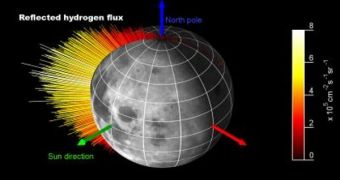The defunct Chandrayaan-1 lunar orbiter, the Indian space probe that slammed into the Moon earlier this year because of a glitch, is still useful even from beyond the “grave.” The analysis of the data relayed back by the ESA-ISRO instrument SARA aboard the spacecraft has helped experts at the European Space Agency (ESA) determine how the Moon is able to form water by itself, and it would appear that the secret is that it acts like a sponge.
According to the readings, the Earth's natural satellite is able to absorb the energetic radiations emitted by the Sun, which then interact with the oxygen stored in certain types of dust grains on the lunar surface. The chemical reaction produces water as a byproduct, the ESA team reports. The data may have also provided astronomers with a new way of taking images of the Moon, as well as of other celestial bodies in the solar system that have no air above their surfaces.
The irregular collection of dust particles that make up the lunar soil is known as regolith. Particles riding solar winds slam into this amalgam, and get absorbed in the free spaces between the grains. As this happens, the protons they carry interact with the oxygen stored in the dust and form hydroxyl and water. This find was recently confirmed by another instrument on the defunct space probe, the Moon Mineralogy Mapper (M3), when the scientific payload identified the specific signatures these byproducts gave off.
“We didn't expect to see this at all,” Swedish Institute of Space Physics expert Stas Barabash says. He is the principal European investigator for the SARA instrument, the Sub-keV Atom Reflecting Analyzer, which was responsible for making the find. The payload's results also hinted at what appeared to be a mystery: while most of the protons from the Sun were, indeed, absorbed, some were not, and astrophysicists have no idea why this difference occurs at this point.
But this mystery has also paved the way for a new type of imaging techniques. As the protons slam powerfully into the Moon, they are deflected back into space, and escape the lunar gravitational pull at velocities of up to 200 kilometers per second. Because the hydrogen is also electrically neutral, it is not diverted by the magnetic fields it may encounter in space. This means that the protons fly in a straight line, and also that, at least in theory, their trajectories could be traced back to their origins, the team says.

 14 DAY TRIAL //
14 DAY TRIAL //